| 1 | France’s deadliest snake |
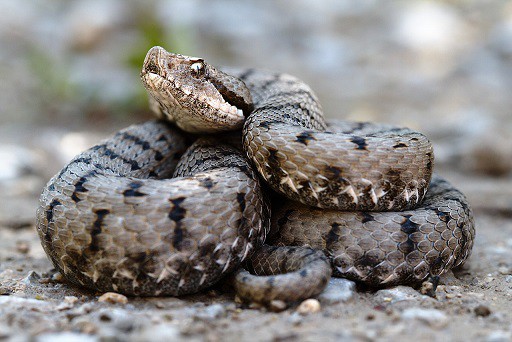
France has 12 snake species in total, of which 3 are venomous. Only one can be the deadliest, and that award goes to the asp viper, or Vipera aspis, a close relative of the UK’s infamous adder (Vipera berus).
The asp viper is a small snake, with an average length of 40-70cm, and a record of 82cm. They’re easily the most common venomous snake in France, controlling approximately the lower 75% of the country, with the more cold-adapted adder controlling the northern 25%. Further afield, asp vipers are found in all of Italy, the Pyrenees areas of northern Spain, and the lower two thirds of Switzerland (alpine regions).
Asp vipers are found in forests occasionally, but avoid the darkest, gloomiest forests where rays of light can barely penetrate the leaves. Instead, this is a countryside snake. Asp vipers are particularly common in grassy fields with overgrown edges, particularly ones with thick hedges along their borders, which they use as a sort of corridor.
The more intensely farmed a landscape is, the more this venomous snake will disappear from it. Asp vipers appear at a variety of altitudes, from just above sea level to towering mountain slopes. The Pyrenees record was 2930 metres, while the alps record stands at 3300m (Valais in Switzerland).
| 2 | Common in hedges and meadows |
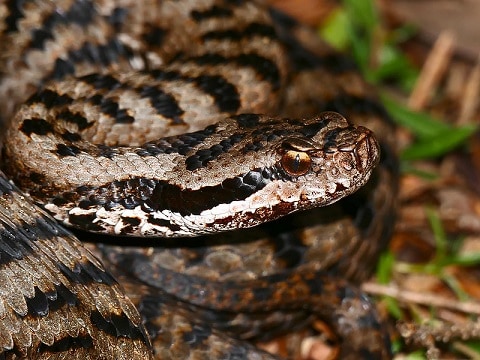
Asp vipers fall well short of the black mamba or king cobra for annual death count, but still bite an average of 300 French people per year. In Italy, the asp viper is found across the entire country, and is responsible for 90% of fatal snakebites. 4% of untreated bites are fatal, and there’s several documented cases to report, including a horribly unlucky 45 year old man who died within 5 minutes in July 2014. This man was otherwise healthy, and was only bitten on the thigh. Small children are more vulnerable, as a 2 year old boy once succumbed to a bite after spending 3 days in hospital.
Unlike the grass snake, asp vipers aren’t creatures of the water, as they’re only rarely spotted swimming. They vary in appearance, particularly their colour, which can be either brown, beige, grey or even yellowish. However, they almost always have some form of jet black pattern, where it’s blotches or encircling bands. One of the most consistent ID signs is a jet black stripe extending backwards from their eye (see above).
Asp vipers have a bulky head with a slightly upturned snout, and their pupils are always sharply vertical like a rattlesnake’s. They look similar to other vipers across Europe such as the adder, but in most of their French and Italian territory, there’s no other snake that closely resembles them.
| 3 | Plummeting blood pressure |

Asp viper venom has an LD50 toxicity score of 1.01mg in mice, which is only slightly weaker than the 0.9mg of a king cobra. The difference between the two is the far lower venom yield of 9-10mg per bite in asp viper, versus a gargantuan 500mg for a king cobra. A king cobra can even latch onto your arm and deliberately keep chewing to inject more and more venom…
That said, asp vipers are not to be underestimated in any circumstances. In France, the symptoms have 3 different gradings of severity, with grade 1 being purely local. An asp viper bite lasts for merely 3 seconds, so if you fall victim to a sudden viper strike, you’ll only notice a short sharp pain. A few minutes later, the flesh surrounding the bite will swell, accompanied by a hot, radiating pain.
These symptoms normally fade after 24-72 uncomfortable hours, and this is where most asp viper bites stop. But grade 2 is when the effects become systematic. Within 24 hours, the victim experiences vomiting, abdominal pain, and general malaise. The earliest systematic effect, a drop in blood pressure, can occur within 30 minutes.
Finally, there’s grade 3, where death is an everpresent risk. The final cause of death is usually kidney failure, but other advanced symptoms include low oxygen levels, severe bleeding (or sometimes completely halted bleeding) and lung lesions. One relatively unique effect of asp viper venom is temporary blindness, caused by the venom destroying eye cells.
| 4 | Particularly deadly near Nice |
Asp viper venom isn’t known for its neurotoxins, the toxin class responsible for muscle weakness, paralysis and lung failure in other snakes. But in the 1990s, reports began to trickle in from southeast France of bites with unusual effects, including drooping eyelids (ptosis) and difficulty swallowing.
These were members of the usual Vipera aspis aspis subspecies found all over France, so there was no reason for their venom to be different. Herpetologists arrived on the scene, and discovered that in narrow areas, the asp viper’s venom did have neurotoxins. In Nice, these included ammodytoxins and vaspis, while in Montpellier, they included phospholipase A2. The venom profile was far closer to the nose-horned viper of southeast Europe, the most feared viper on European soil.
The asp vipers in the vast majority of France (and Switzerland and Italy) lacked these neurotoxins, but in terms of physical appearance, this supertoxic subpopulation was nearly indistinguishable. This is one local talent the tourism boards of Nice probably won’t mention in their glossy brochures.
| 5 | Diet: overwhelmingly mammals |
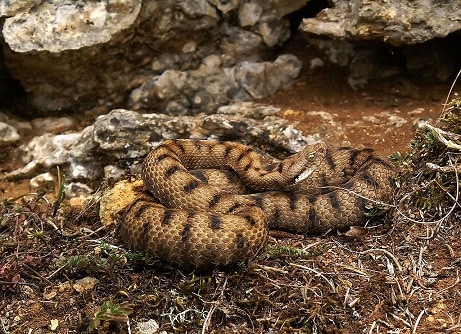
Among all French and Italian snakes, the asp viper is probably the one most heavily reliant on mammals. A study from Italy’s Tolfa mountains found that they derived 81.4% of meals from mammals, including house mice and common shrews.
In some areas, they get even more specific. One report stated that 98% of their meals consisted of one small mammal – the common European vole (Microtus arvalis). This vole weighs just 1 pound and has an average body length of 10cm. it inhabits all of Europe except for Scandinavia and the UK, and scurries through the same thick hedges where asp vipers love to hang out.
In some regions, asp vipers favour voles so heavily that their populations are closely intertwined; when voles fall, so do the snakes. Baby asp vipers acquire 81% of their food from reptiles, until they reach the magic length of 35cm, when their taste buds dramatically transform.
Meanwhile, asp vipers are hunted themselves by falcons and members of the Corvidae bird group (crows, rooks, ravens). This is partly why they favour the thick protection of tangled hedgerows.
| 6 | No innate desire to kill |
In India, there are villages which are under constant attack from cobras and neurotoxic kraits, not to mention the unusually aggressive mugger crocodile lurking in rivers. The asp viper doesn’t subscribe to this mentality – instead, it’s part of the defensive school of snakes. Asp vipers are rarely aggressive towards random passersby, and they definitely won’t slither up a toilet pipe in a malicious attempt to bite the person sitting on it. They even move through the undergrowth fairly slowly.
The danger usually occurs when nature mad explorers pick them up, believing themselves to be all-powerful snake whisperers. Unlike grass snakes, which usually play dead, asp vipers are spooked by any form of human touch, and will spiral into an aggressive rage in seconds. Another cause is when people lift up the loose rocks they shelter under.
Never underestimate an asp viper, as even babies (neonates) are capable of triggering a serious medical episode. Another death occurred in July 1996, when a 69 year old French woman was bitten on the thigh. She didn’t perish within 5 minutes like the man above, but her symptoms rapidly progressed to stage 3, and she later died in hospital, where an infusion of antivenom couldn’t save her.
| 7 | Their populations are plummeting |
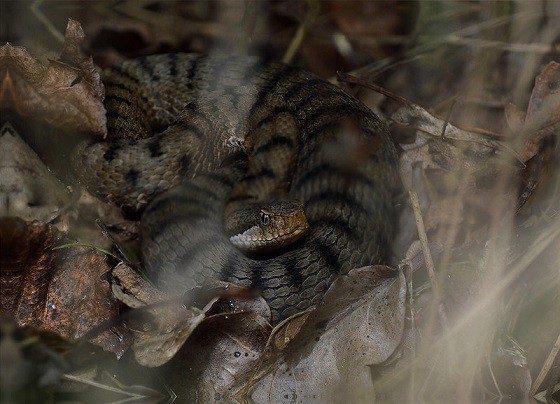
Asp vipers were once abundant across most of France. Technically, their range still covers most of the country, but farmers report an increasing rarity over the last 50 years. Within their range, they’re withdrawing to ever more isolated pockets.
It’s no mystery why this has happened. It was a deliberate extermination, initiated on August 22nd 1863 when the Deux-Sèvres General Council decided to grant a bonus of 25 centimes of francs for every asp viper killed, with its skin being taken as proof.
Despite its elusive nature, the temptation of cash was enough to motivate people, and 7000 asp vipers were killed over the next 6 months alone. Between 1883 and 1900, Henri Gelin estimated that 60,000 were killed in the Deux-Sèvres region, followed by 6,774 in 1905, which amounted to a healthy reward of 1,374.80 francs.
Those are only the years for which figures are readily available. Asp vipers aren’t at imminent risk of extinction, and are rated as “least concern” by IUCN, but they’re at huge risk from their favourite habitat being cut down: thick hedges.
| 8 | Habitat destruction |
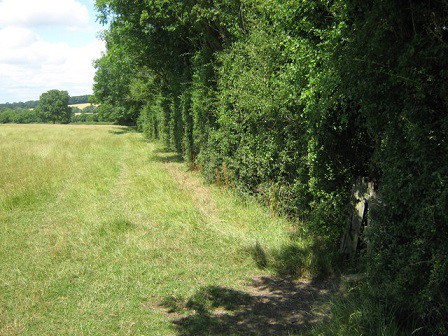
In 2011 and 2012, scientists embarked upon an epic study of bocages. This is a type of agricultural field common in France, which is wilder than average and typically bordered by tall grass and thick hedges. In other words: perfect asp viper habitat. The scientists analysed 142 individual snake habitats, and conducted eight separate 300 hour recording sessions for each one.
Of the 8 snake species they were searching for, the asp viper was only spotted 64 times. This was spread between 15 of the 142 bocage fields. The figure wasn’t horrendously low, but the study was already focussing on the best possible habitat.
Since the 1960s, 40-80% of French asp viper groves have disappeared or been seriously damaged, with 1.4 million kilometres of hedges being cut down. It’s believed that the species benefitted from agriculture until about 1950, when modern practises became too intensive and the balance tipped.
Consequently, the asp viper is a more endangered species than most. But in February 2021, a light shone through, as the French government finally granted the asp viper protected status along with the common European adder. This applied not just to the snake, but to its bocage and bushy hedge habitats.
| 9 | The asp viper dunes (watch out) |
If this article has planted the seeds of nightmares in your brain, then there’s one place you should never visit – Breville-sur-Mer in northwest France (Normandy). This popular tourist beach is located near the English channel, and is home to gloriously scenic dunes. Unfortunately, despite these dunes lying well outside the asp viper’s natural range, they’re now home to a thriving, slithering colony.
Earlier in 2021, a dog was bitten on the dunes of Bréville-sur-Mer, later dying in hospital. In April 2020, a woman was bitten on the foot by an asp viper in the same dunes, closer to the town of Pirou. In 2004, the local authority launched a 5 year capture plan, to rid the dunes of asp vipers once and for all, and make them safe for people once again. but they evidently failed judging by the recent reports.
Warning signs read “Caution – vipers present”. The sandy dunes are also adjacent to a golf course, who have to drive and putt with the knowledge that crafty vipers are watching their every move (maybe). The snake shouldn’t have been there in the first place, as the population was introduced artificially in the 1980s by a reptile enthusiast. Because asp vipers aren’t particularly adventurous, the snakes remained stuck in the dunes, where they survived and thrived.
To avoid a venomous bite, the authorities advise people to avoid the dunes and stick to the flatter sand. But vipers are flexible, as adders have been found found relaxing on UK breaches in recent times. Our recommendation – don’t go anywhere near the asp viper dunes.
| 10 | 5 subspecies across Europe |
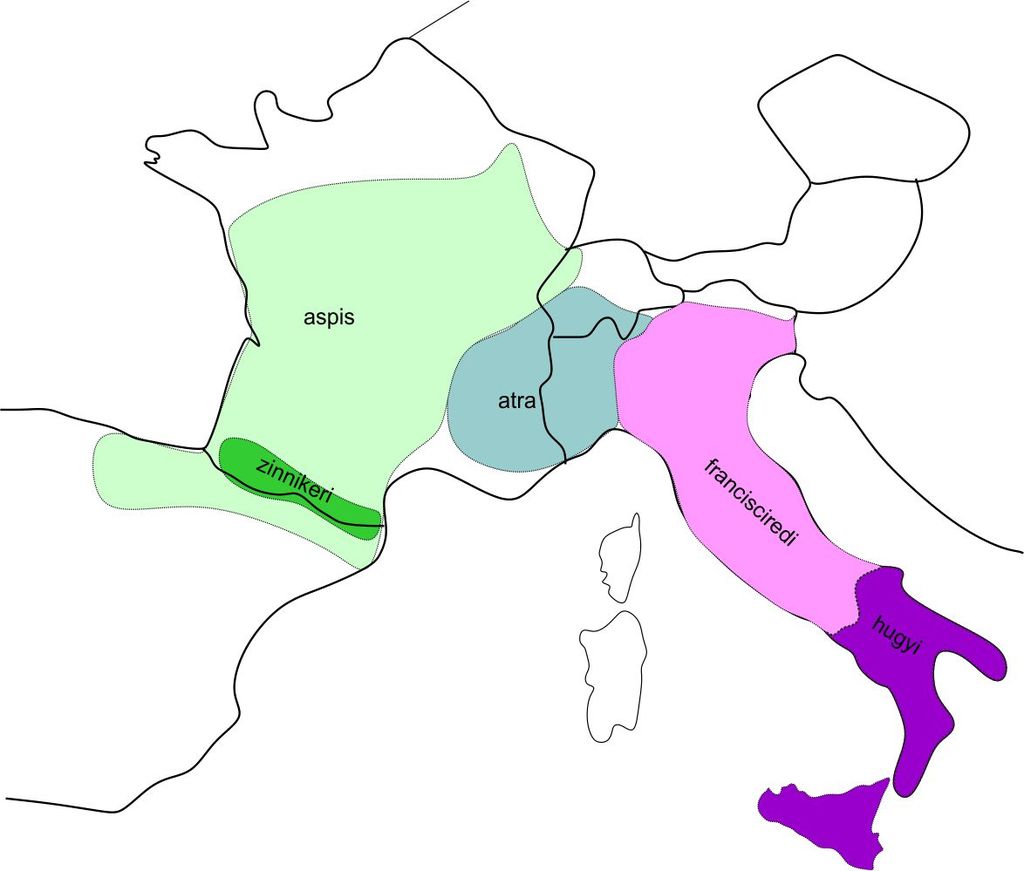
Here’s a quick guide to the 5 asp viper subspecies and where they live…
Vipera aspis aspis – the main subspecies, and the dominant one in France (including the secret neurotoxic enclave). Also found in northwest Switzerland and Germany’s extreme southwest.
Vipera aspis astra – the alpine subspecies, including most of Switzerland and Italy’s far north. This version has larger dark bars, which sometimes connect to form rings. Melanistic (fully black) snakes are particularly common with this subspecies.
Vipera aspis francisciredi – the main Italian version, living as far south as Naples. Has a significantly wider head, but thinner and more widely spaced dark bars (dorsal bars).
Vipera aspis hugyi – far southern Italy, including Sicily. This subspecies has circular dark dorsal marks instead of bar shaped. The island of Montecristo had a “subspecies” called v.a.montechristi which was proven by genetics to simply be v.a. aspis; it’s believed that they were introduced from Sicily between 900 and 300BC.
Vipera aspis zinnikeri – the Pyrenees subspecies. This mountainous asp viper is so different that some biologists consider it to be a separate species. Its nose is much less upturned, and the dark dorsal bars barely exist.
| 11 | Pierced by a lizard |
There’s a good reason why asp vipers stick to mammals, as sometimes their attempts to eat other creatures go catastrophically wrong. Failed feeding attempts are everywhere with snakes. Brown watersnakes (Texas, Louisiana) commonly die after catfish spines puncture their bodies, or alternatively, survive for several years with the spines still embedded in their bodies. In October 2019, an asp viper paid the ultimate price after swallowing a western green lizard. This species lives in western Europe, including a large chunk of France, and has a brightly green and blue body which would look more at home in Thailand.
The asp viper was already diverging from its trusted food supply, and things soon got worse. The incident took place in Calabria, southern Italy, and the asp viper was moving normally, yet clearly had part of its prey protruding from a brutal laceration in its belly.
The researchers picked up the viper to see if they could assist, but over the next few minutes, the lizard completely burst out of the puncture hole. It measured 15cm, with a weight of 17.5kg. The asp viper measured 33cm and weighed 14kg, making it lighter than its prey, with an overall predator to prey weight ratio of 125%. No wonder the bulky lizard burst out of its body.
Miraculously, the asp viper survived this, despite the scenario barely being any different to the infamous scene from Alien. The viper slithered into the Italian underground, and its eventual fate remained unknown.
| 12 | Asp vipers in Switzerland |
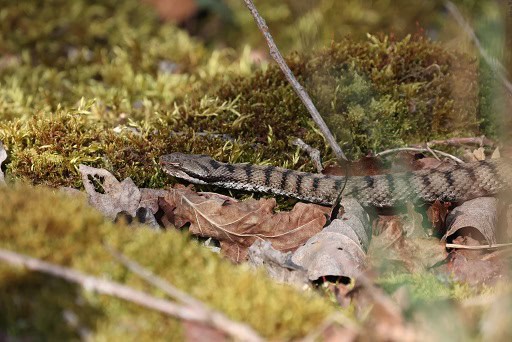
Switzerland has a large chunk of territory where the asp viper rules supreme, but the country is also home to the adder (Vipera berus), the UK and Scandinavia’s main viper. The two species have a small overlap in central Switzerland, but are mainly separated. Asp vipers dominate the alpine southern half of Switzerland, as well as most western areas bordering France. Adders take over the further northeast you travel.
If you stumble across a hissing viper in a pile of rocks while hiking in the Swiss alps, it’s most likely to be the asp viper. In Austria, the situation is the reverse; asp vipers only inhabit the extreme southwest of the country, and any high altitude viper you meet is almost certainly the adder.
In 2005, a study covered 99 asp viper bites inflicted on Swiss citizens from 1973 to 2004. There was one death, which predictably was a 2 year old child. 68 of 99 bites were delivered to the hands and forearms, sometimes when victims picked the asp viper up (unwisely).
27 bites were delivered to the ankles and feet, sometimes when victims accidentally stepped on an unseen viper. Many bites occurred when victims moved loose rocks and stones that the asp viper was resting peacefully under. Keep this is in mind when hiking through a lush alpine meadow, believing that cows are all you have to worry about.
| 13 | Fate of an asp viper victim |
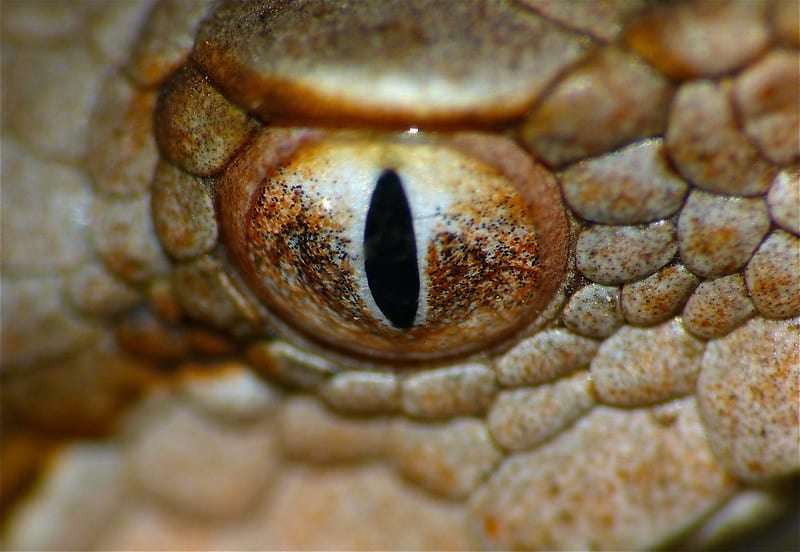
Summer was clearly the worst season in Switzerland for asp viper bites, with July ranking first, followed by June and August. As for symptoms, 10 of the 96 victims who had full data reached grade 3, the highest severity, while 48 reached grade 2 or higher. Aside from “pain”, which affected almost everyone, the most common symptom was swelling of the limbs, affecting 48 of 96 patients.
The more severe symptoms included vomiting and abdominal pain, affecting 18 of 96 patients. Blood coagulation mayhem was surprisingly rare, affecting 4 patients of 64 tested, but aenemia was slightly more common (10 of 64). Necrosis and blisters were rare, affecting just 7 of 96 patients between them.
Only 2 victims of 96 suffered from dyspnoea, or shortness of breath. 8 victims of 64 suffered from thrombocytopenia, when the platelets that stick to together and plug wounds fall to dangerously low levels in your bloodstream.
Vineyards were a surprisingly common place to be bitten in Switzerland. The asp vipers didn’t climb the grape vines themselves, but lurked in the warm, open rocky ground between them. As you may know, southern France also has many vineyards, so keep this in mind on a wine tour, in case you hear a strange hissing sound which your smiling tour guide assures you is nothing to worry about.
